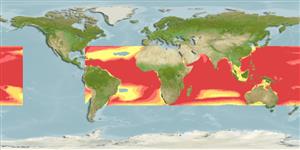>
Myctophiformes (Lanternfishes) >
Myctophidae (Lanternfishes) > Diaphinae
Etymology: Diaphus: Greek, dis, dia = through + Greek, physa, phyo = to beget, to have as offspring (Ref. 45335).
Environment: milieu / climate zone / depth range / distribution range
Ökologie
seewasser bathypelagisch; ozeanodrom (Ref. 51243); tiefenbereich 15 - 1313 m (Ref. 44036). Deep-water; 35°N - 36°S, 78°W - 153°W
Tropical areas in all three oceans, with western boundary current extensions: Atlantic: to Slope Water edge and to 26°S. Indian Ocean: Agulhas Current to about 36°S. Western Pacific: in Kuroshio to 35°N and East Australian Current to about 34°S. South China Sea (Ref.74511).
Length at first maturity / Size / Gewicht / Alter
Maturity: Lm ?, range 6 - ? cm
Max length : 12.3 cm SL Männchen/unbestimmt; (Ref. 95664)
Rückenflossenstacheln (insgesamt) : 0; Rückenflossenweichstrahlen (insgesamt) : 17 - 19; Afterflossenstacheln: 0; Afterflossenweichstrahlen: 16 - 18.
Mesopelagic (Ref. 58302). Oceanic species found at 520-600 m by day and at 15-125 m by night (Ref. 4479).
Specimens reach sexual maturity at a length of 7,3 cm (Ref. 47377).
Life cycle and mating behavior
Geschlechtsreife | Fortpflanzung | Ablaichen | Eier | Fecundity | Larven
Hulley, P.A., 1990. Myctophidae. p. 398-467. In J.C. Quero, J.C. Hureau, C. Karrer, A. Post and L. Saldanha (eds.) Check-list of the fishes of the eastern tropical Atlantic (CLOFETA). JNICT, Lisbon; SEI; Paris; and UNESCO, Paris. Vol. 1. (Ref. 4479)
IUCN Rote Liste Status (Ref. 130435: Version 2024-2)
Bedrohung für Menschen
Harmless
Nutzung durch Menschen
Tools
Zusatzinformationen
Download XML
Internet Quellen
Estimates based on models
Preferred temperature (Ref.
123201): 8 - 18.5, mean 11.8 °C (based on 792 cells).
Phylogenetic diversity index (Ref.
82804): PD
50 = 0.5000 [Uniqueness, from 0.5 = low to 2.0 = high].
Bayesian length-weight: a=0.00776 (0.00422 - 0.01428), b=3.03 (2.87 - 3.19), in cm total length, based on LWR estimates for this species & Genus-body shape (Ref.
93245).
Trophic level (Ref.
69278): 3.1 ±0.16 se; based on food items.
Widerstandsfähigkeit (Ref.
120179): mittel, Verdopplung der Population dauert 1,4 - 4,4 Jahre. (Preliminary K or Fecundity.).
Fishing Vulnerability (Ref.
59153): Low vulnerability (10 of 100).
